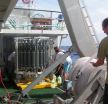(Press-News.org) GAINESVILLE, Fla. — University of Florida researchers say their supercomputer, named Novo-G, is the world's fastest reconfigurable supercomputer and is able to perform some important science applications faster than the Chinese supercomputer touted as the world's most powerful.
In November, the TOP500 list of the world's most powerful supercomputers, for the first time ever, named the Chinese Tianhe-1A system at the National Computer Center in Tainjin, China as No. 1.
In his state of the union speech, President Barack Obama noted, "Just recently, China became home of the world's largest solar research facility, and the world's fastest computer."
But that list does not include reconfigurable supercomputers such as Novo-G, built and developed at the University of Florida, said Alan George, professor of electrical and computer engineering, and director of the National Science Foundation's Center for High-Performance Reconfigurable Computing, known as CHREC.
"Novo-G is believed to be the most powerful reconfigurable machine on the planet and, for some applications, it is the most powerful computer of any kind on the planet," George said.
"It is very difficult to accurately rank supercomputers because it depends upon what you want them to do," George said, adding that the TOP500 list ranks supercomputers by their performance on a few basic routines in linear algebra using 64-bit, floating-point arithmetic.
However, a significant number of the most important applications in the world do not adhere to that standard, including a growing list of vital applications in health and life sciences, signal and image processing, financial science, and more under study with Novo-G at Florida.
Most of the world's computers, from smart-phones to laptops to Tianhe-1A, feature microprocessors with fixed-logic hardware structures. All software applications for these systems must conform to these fixed structures, which can lead to a significant loss in speed and increase in energy consumption.
By contrast, with reconfigurable machines, a relatively new and highly innovative form of computing, the architecture can adapt to match the unique needs of each application, which can lead to much faster speed and less wasted energy due to adaptive hardware customization.
Novo-G uses 192 reconfigurable processors and "can rival the speed of the world's largest supercomputers at a tiny fraction of their cost, size, power, and cooling," the researchers noted in a new article on Novo-G published in the January-February edition of the IEEE Computing in Science and Engineering magazine.
Conventional supercomputers, some the size of a large building, can consume up to millions of watts of electrical power, generating massive amounts of heat, whereas Novo-G is about the size of two home refrigerators and consumes less than 8,000 watts.
Later this year, researchers will double the reconfigurable capacity of Novo-G, an upgrade only requiring a modest increase in size, power, and cooling, unlike upgrades with conventional supercomputers.
In their article, the researchers discuss Novo-G and its obvious advantages for use in certain applications such as genome research, cancer diagnosis, plant science, and the ability to analyze large data sets.
Herman Lam, an electrical and computer engineering professor and co-investigator on Novo-G, said some vital science applications that can take months or years to run on a personal computer can run in minutes or hours on the Novo-G, such as applications for DNA sequence alignment at UF's Interdisciplinary Center for Biotechnology Research.
INFORMATION:
CHREC is comprised of research sites at four universities including Florida, Brigham Young, George Washington and Virginia Tech. In addition, there are more than 30 partners in CHREC, such as the U.S. Air Force, Army, and Navy, NASA, National Security Agency, Boeing, Honeywell, Lockheed Martin, Monsanto, Northrop Grumman, and the Los Alamos, Oak Ridge and Sandia National Labs.
Credits
Writer
Ron Word, rword@ufl.edu, 352-392-0186
Source
Herman Lam, hlam@ufl.edu, 352-392-2689
Source
Alan George, ageorge@ufl.edu, 352-392-5225
END
Alexandria, VA – The U.S. had two key strategic advantages over the Axis in World War II: oil and water. Although other factors played major roles in the U.S. and its allies winning the war, these two natural resources played a much larger role than recognized.
World War II was the first highly mechanized war. In the March feature "How Oil and Water Helped the U.S. Win World War II," EARTH magazine explores how the abundance of domestic US oil and water in the South and Pacific Northwest drove not only tanks and planes, but also industrial production and technological ...
OAK BROOK, Ill. – Feb. 15, 2011 – Researchers from Korea report that, compared with conventional sedation, balanced propofol sedation (BPS) using propofol in combination with midazolam and meperidine, provided higher health care provider satisfaction, better patient cooperation, and similar adverse event profiles in patients undergoing therapeutic endoscopic procedures. This is the first prospective study of BPS in direct comparison with conventional sedation. The researchers note that this study provides further evidence to support the adoption of endoscopist-directed ...
Bethesda, MD - William T. Talman, MD, President of the Federation of American Societies for Experimental Biology (FASEB), praised President Barack Obama for his continuing support for science and engineering. "The President recognizes that our future depends on research," Talman stated. In a letter to President Obama, Talman noted that his "support for this critical investment—even during a time of unprecedented budgetary constraints—will help to improve the lives of millions of people."
In his FY 2012 Budget, President Obama proposed a $745 million increase over the ...
Composed of diverse elements, mostly of plastic, with little metal used, improvised explosive devices are very difficult to detect. In cooperation with two colombian universities, scientists at EPFL's Electromagnetic Compatibility Laboratory have found a solution. They have developed a device enabling the remote explosion of these mines, by using the energy from their electromagnetic impulses.
This type of mine is often used by guerillas or terrorist groups in conflict zones, and is present in many regions of the world, such as Colombia, Iraq and Afghanistan. They kill ...
MIAMI – Feb 15, 2011 – A study by scientists at the University of Miami (UM) Rosenstiel School of Marine & Atmospheric Science suggests a new way to estimate how much of the ocean's pollution is falling from the sky. The new findings can help improve scientific understanding of how toxic airborne chemicals, from the burning of fossil fuels and industrial power plants emissions, are impacting the oceans globally.
By measuring Beryllium-7 (7Be) isotope concentrations in the ocean, which is found naturally throughout Earth's atmosphere, Rosenstiel School scientists David ...
Potholes in the road or a park bench in need of repair – we all come across these or similar problems every now and then. If only there were a simple way of reporting them to the right department of the public administration! The latest mashup technology and mobile applications make it possible to come up with solutions.
Inspired by the UK website www.fixmystreet.com, the Fraunhofer Institute for Open Communication Systems FOKUS in Berlin is taking this approach further. Damage reports can be assigned GPS coordinates by cell phone and entered. The system then provides ...
You might think that a loving partner helps keep you on track—say, when you want to stick to your jogging or concentrate on your studies. But a new study in Psychological Science, a publication of the Association of Psychological Science, reports the opposite: Thinking about the support a significant other offers in pursuing goals can undermine the motivation to work toward those goals—and can increase procrastination before getting down to work.
The study's authors, psychological scientists Gráinne M. Fitzsimons of Duke University and Eli J. Finkel of Northwestern University, ...
The auto industry faces major challenges. New models are entering the market at ever shorter intervals, products are becoming more complex, and the trend towards electric cars requires modified vehicle structures. European production sites are coming under increasing cost pressure from low-wage countries. Cost reductions, shorter production times, new materials and innovative assembly techniques are needed if companies are to remain competitive. To achieve these goals, 23 business and research organizations are participating in the EU's Pegasus project (www.pegasus-eu.net). ...
Just when everyone thought that almost every plant species on the Iberian Peninsula had been discovered, Spanish researchers have discovered Taraxacum decastroi and Taraxacum lacianense, two dandelions from the Pyrenees and the Cordillera Cantábrica mountain range, respectively. This finding confirms Spain's privileged position as a hotbed of biodiversity.
"It's hard to find new species now in Spain. It depends on the complexity of the group of plants you study", Antonio Galán de Mera, lead author of the study and a researcher in the Department of Biology (Botany) at ...
WASHINGTON – A National Research Council committee asked to examine the scientific approaches used and conclusions reached by the Federal Bureau of Investigation during its investigation of the 2001 Bacillus anthracis mailings has determined that it is not possible to reach a definitive conclusion about the origins of the anthrax in letters mailed to New York City and Washington, D.C., based solely on the available scientific evidence.
Findings of the committee's study include:
The FBI correctly identified the dominant organism found in the letters as the Ames strain ...



